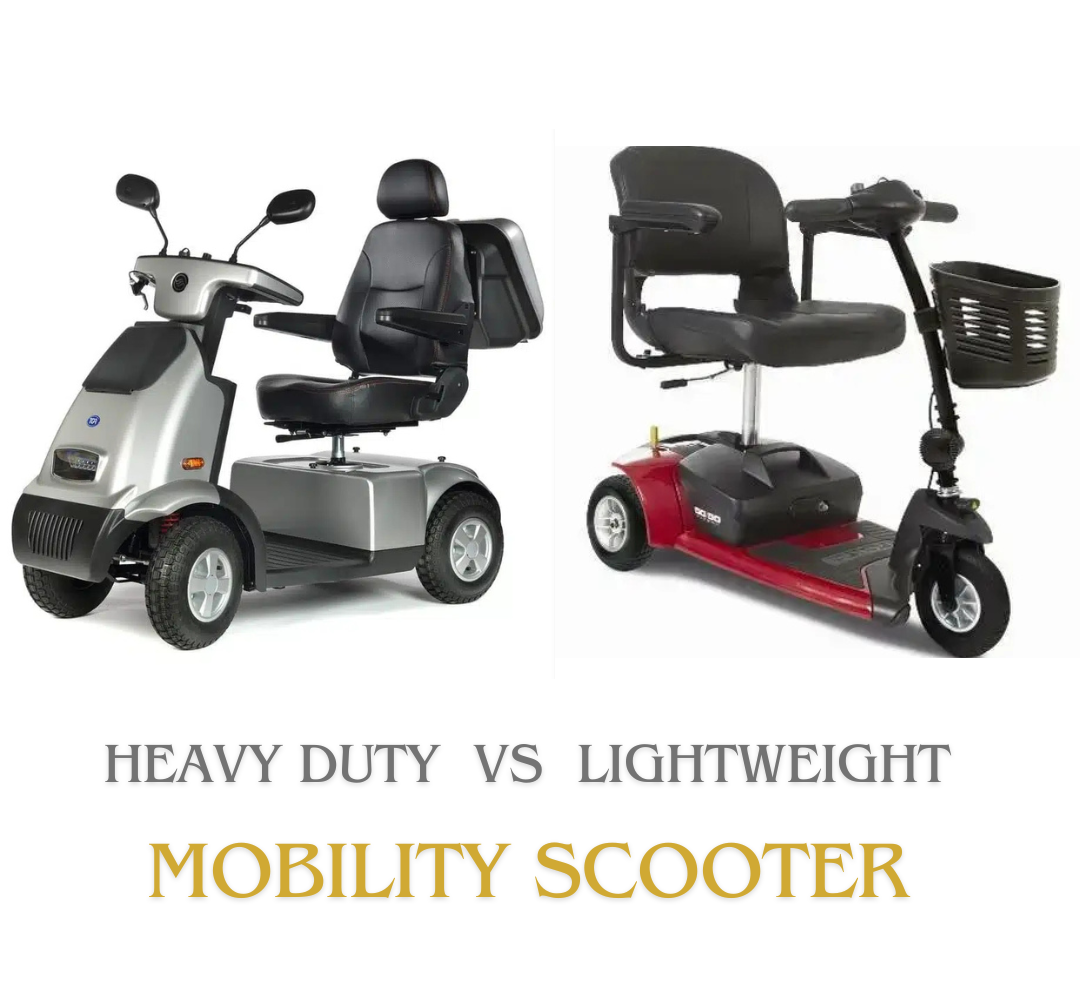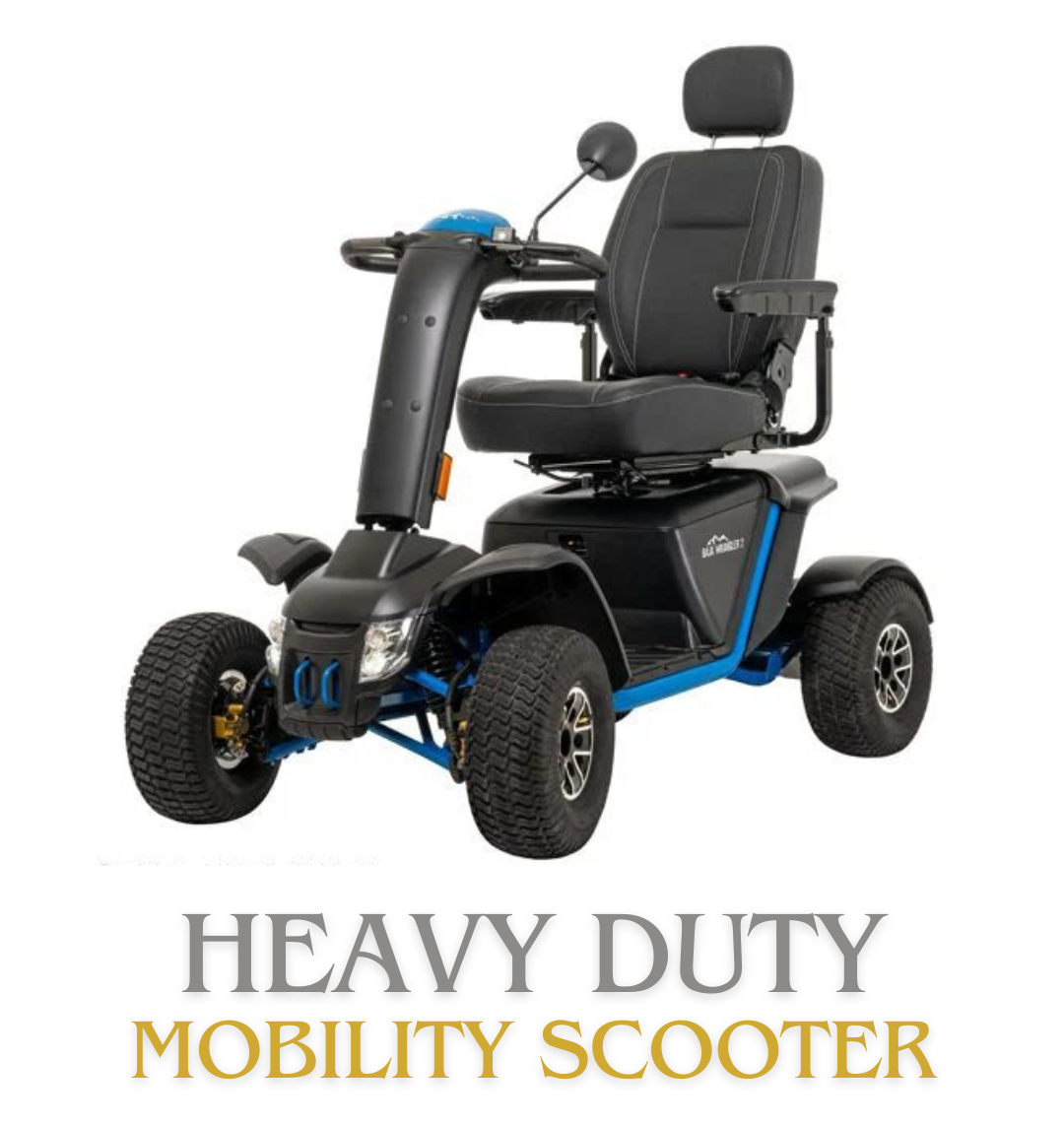- Home
- Heavy Duty Mobility Scooters
Heavy Duty Mobility Scooters Versus Lightweight Mobility Scooters: Which One Fits Your Lifestyle?
Choosing between heavy duty mobility scooters and a lightweight models can feel overwhelming. Whether you're navigating indoor spaces or tackling rough terrain outdoors,
If you’ve ever found yourself unsure about which path to take, you’re not alone.
Mobility scooters have transformed the lives of many individuals with limited mobility. With many options ranging from sleek, foldable designs to rugged, heavy-duty models built for endurance, it's easy to feel overwhelmed. Picking the right mobility scooter can feel like navigating a maze of features, specifications, and personal needs. especially when your independence, comfort, and everyday mobility are at stake.
Not everyone needs the same level of support or the same type of scooter. Some users need compact models that glide through narrow doorways and fit easily in a car boot, while others require the strength and stamina of heavy duty mobility scooters to confidently handle uneven terrain and longer distances.
What works beautifully for one lifestyle may fall short for another.
That’s why this guide was created. Rather than diving into brands or buzzwords, we’ll focus entirely on functionality—breaking down what each type of scooter actually offers in real-life scenarios.
You'll gain insight into range, comfort, portability, terrain compatibility, and everyday usability. By the end, you’ll be able to match your personal needs to the right mobility solution—empowering you to make an informed decision and move through life with greater ease and confidence.

What Is a Heavy Duty Mobility Scooter?
Heavy-duty mobility scooters are engineered for users who require extra stability, higher weight capacity, and enhanced durability. These scooters feature reinforced frames, powerful motors, and larger batteries, making them ideal for outdoor use and rough terrain.
Key Features of Heavy Duty Mobility Scooters
- Higher Weight Capacity – Supports 160-230 kg, ideal for bariatric users.
- Longer Battery Range – Equipped with dual or high-capacity batteries for extended travel (up to 50-80 km per charge).
- Sturdy Construction – Reinforced steel or aluminium frames with wider bases for superior stability.
- All-Terrain Performance – Many feature pneumatic tires, suspension systems, and powerful motors (500W+) for navigating grass, gravel, and uneven surfaces.
- Comfortable Seating – Larger, padded seats (45-50 cm wide) with adjustable armrests and backrests.
Best Uses for a Heavy Duty Mobility Scooter
- Outdoor travel (parks, sidewalks, trails)
- Users with higher weight requirements
- Those needing long-distance travel without frequent recharging
- Rough or uneven terrain
What Are Lightweight Mobility Scooters?
Lightweight mobility scooters prioritize portability and convenience. They are best suited for users who frequently travel, need easy transport, or have limited storage space.
Key Features of Lightweight Mobility Scooters
- Compact & Portable – Weighs 23-45 kg, with some models being foldable or easily disassembled.
- Lower Weight Capacity – Typically supports 115-140 kg.
- Shorter Range – Smaller batteries provide 15-25 km per charge.
- Easier Transport – Fits in car boots or can be taken on public transport.
- Smooth Indoor Use – Tight turning radius (under 1.2 metres) for navigating shops and homes.
Best Uses for Lightweight Mobility Scooters
- Indoor navigation (malls, supermarkets, homes)
- Frequent travellers (easy to transport in a car or plane)
- Users with limited storage space
- Those who need a secondary scooter for short trips
Heavy Duty vs. Lightweight: A Detailed Comparison
When deciding between a heavy-duty and lightweight mobility scooter, it's important to understand how their differences impact real-world use. Let's examine these two types in depth to help you make the best choice for your mobility needs.
Weight Capacity and User Suitability
The most fundamental difference lies in their weight capacities. Heavy-duty models are built to support users weighing up to 230 kg, making them ideal for bariatric individuals or those who need extra sturdy construction. These scooters feature reinforced frames and wider bases to handle the additional weight safely.
In contrast, lightweight scooters typically accommodate up to 140 kg, catering to average-sized users who prioritize portability over maximum capacity.
Battery Life and Travel Range
Battery performance varies significantly between these two types. Heavy-duty scooters boast extended-range batteries that can travel 50-80 km on a single charge, perfect for users who need all-day mobility or frequently travel longer distances. Their larger battery capacity also means less frequent charging.
Lightweight models, with their more compact power systems, offer 15-25 km per charge - sufficient for short trips and indoor use but requiring more frequent recharging for active users.
Portability and Transportation
Transportation needs present one of the clearest distinctions. Lightweight scooters shine in this area, weighing just 23-45 kg with many models featuring foldable or disassemblable designs. This makes them easy to lift into a car boot or take on public transport.
Heavy-duty models, weighing 90-150 kg, require vehicle ramps or specially adapted vans for transport. While less portable, their sturdier construction provides greater stability during use.
Terrain Handling and Performance
Outdoor performance differs dramatically between these scooters. Heavy-duty models are built for challenging terrain, featuring powerful 500W+ motors, pneumatic tires, and often suspension systems to handle grass, gravel, and uneven surfaces comfortably.
Lightweight scooters excel on smooth pavements and indoor surfaces, with their smaller wheels and lighter frames making them more maneuverable in tight spaces but less capable on rough ground.
Comfort and Seating
Seating comfort varies according to design priorities. Heavy-duty scooters offer larger, more padded seats (45-50 cm wide) with adjustable features to support prolonged use. Their wider bases also provide more legroom.
Lightweight models have more compact seating to save space and weight, which may be less comfortable for extended periods but perfectly adequate for shorter trips.
Storage Considerations
Storage needs differ substantially. Lightweight scooters are ideal for small homes or apartments, with some models folding down to fit in closets.
Heavy-duty models require more dedicated space, whether in a garage or specially allocated area, due to their larger dimensions and inability to fold.
Making Your Decision
Ultimately, your choice depends on your primary usage patterns. If you need a scooter for outdoor adventures, have higher weight requirements, or value extended range, a heavy-duty model will serve you best.
If portability, indoor use, and easy transport are priorities, a lightweight scooter makes more sense. Consider where and how you'll use the scooter most frequently to guide your decision.
By understanding these key differences in functionality, you can select the mobility scooter that truly matches your lifestyle and needs, ensuring optimal comfort and independence in your daily activities.

Who Benefits Most from Heavy Duty Mobility Scooters?
A heavy duty mobility scooter makes sense if:
- You have a larger frame or want extra legroom
- Your lifestyle involves longer outings or irregular terrain
- You need a scooter for all-day use
- You prioritize comfort and sturdiness over ease of transport
- You live in suburban or rural areas with less developed paths
These scooters deliver not only range and support but also peace of mind for users who depend on their scooter for everyday life.
Who Should Choose a Lightweight Scooter?
Go lightweight if:
- You live in an apartment with limited space
- You use public transport or travel by plane frequently
- You only need the scooter for short, periodic outings
- You often rely on others to lift or store the scooter
- You frequent indoor spaces like shopping centres and clinics
Even though it may not be as rugged as a heavy duty mobility scooter, a lightweight model can offer unbeatable convenience for urban and travel-focused users
Real-World User Scenarios
The Trail Explorer
Tina, 68, is passionate about nature photography and uses a heavy duty mobility scooter to navigate trails, muddy slopes, and cobbled streets. The long battery life keeps her outdoors longer, while the wide tires and suspension system provide smooth, stable rides.
The Commuting Professional
Derrick, 72, splits his time between city errands and weekend visits to his daughter. His lightweight scooter folds easily into the car boot and maneuvers effortlessly through shopping centres and public transport stations.
The Independent Senior
Marilyn, 75, lives in a sprawling retirement community. She selected a heavy duty mobility scooter for its consistent performance on outdoor pathways and high level of comfort, enabling her to stay active every day without stress.
Practical Considerations Before Buying
Ask yourself:
- Where will I use this scooter most? Do I need to lift or store it regularly?
- Will I be on flat ground or uneven terrain?
- Am I using the scooter daily or occasionally?
- Do I need to accommodate additional weight or cargo?
If your answers point to frequent outdoor use, stability, and comfort, a heavy duty mobility scooter is likely the better fit. If you prioritize space-saving and mobility, a lightweight version might serve you better.
Accessibility That Reflects Your Lifestyle
One size doesn’t fit all when it comes to mobility aids. Choosing between a lightweight model and a heavy duty mobility scooter is about identifying which features resonate with your routine and physical needs.
Want more terrain freedom and long-term comfort? Heavy duty mobility scooters are your road companion. Prefer compact, go-anywhere convenience? Lightweight has you covered.
Either way, the best mobility scooter is the one that makes you feel unstoppable.

Conclusion
Mobility scooters empower people to reengage with the world. Whether you're tackling trails with heavy duty mobility scooters or gliding through tight corners with a lightweight models, it’s the functionality—how well it fits your body and lifestyle—that determines its true value.
Make a choice that supports your journey, not just your destination.
Back to top. / Back to Homepage



